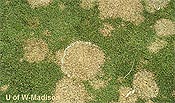Snow Mold
What are the symptoms?
Damage from snow mold fungi usually becomes apparent as the snow melts and exposes the grass in late winter. Snow mold symptoms consist of roughly circular patches (at least 3 to 12 inches) of dead and matted grass blades. In severe cases, these patches coalesce and may not be recognizable as individual circles. Just after snow melt and while the grass remains moist, it may be possible to differentiate between the two common types of snow mold found in New England by their color. The web-like mycelium of pink snow mold may start out looking white and mature to a faint pink to salmon color. Gray snow mold (Typhula spp.) is white to gray in color. The mycelium of both types of fungi will disappear quickly as the grass dries. A useful identifying characteristic of gray snow mold is the presence of tiny brown to black mycelial masses on the blades and in the leaf sheaths of infected plants. These survival structures vary in size and color, becoming smaller and darker as they dry. The pink snow mold fungus does not produce sclerotia.
It is useful to determine whether the disease is pink or gray snow mold because gray snow mold rarely damages more than the blades of the grass. Lawns with gray snow mold can be expected to recover fairly quickly even when damage appears extensive. Pink snow mold, in contrast, may invade the crowns and roots causing more serious injury. It is not unusual for both types of snow mold to be found in the same area. All common lawn grasses may be infected, but Kentucky bluegrass-fescue lawns are the least susceptible to severe damage.
Snow Mold season.
What is the snow mold season? Snow mold fungi are active at temperatures just above freezing in moist conditions. These conditions occur most frequently under snow cover or anything else that covers the grass, such as fallen tree leaves. Gray snow mold usually only occurs after prolonged snow cover. Pink snow mold may be active in cool, wet conditions from late fall through early spring even in the absence of snow or other covers, a factor which greatly enhances its potential as a damaging disease.

Disease cycle.
Snow mold fungi remain inactive during the warm months when other disease fungi are most active. They survive in thatch and on plants as sclerotia (gray snow mold) or as mycelial threads (pink snow mold). In the fall, Typhula species sometimes produce small, white or pinkish, club-shaped spore-producing structures that may be seen among grass blades in lawns that have not been recently mowed. They grow from sclerotia that were produced in the previous winter for survival over the summer.
As cool, wet weather develops, the fungi begin to grow and infect grass plants. Like all living organisms, these fungi require moisture to survive. The cold, dry air of winter prevents active growth. The shelter of leaves, snow or any other cover on the grass maintains the necessary moisture for growth. Optimal conditions for snow mold activity occur when snow falls suddenly and remains on ground that has not yet frozen. In such cases, grass is often still lush, providing an excellent food base for the fungi.
Cultural management.
The most important means of preventing or reducing snow mold problems in lawns is the care of the grass at the end of the summer season. As long as the grass continues to grow, it should be mowed. Fall fertility programs should be timed so that they do not influence the ability of the grass to become dormant for the winter season. Fall fertilizers should be applied more than six weeks before dormancy, or they should be applied after leaf blade growth has stopped but while the grass is still green. Addition of nitrogen fertilizer just before the grass becomes dormant will stimulate a late burst of succulent green growth, making the grass prone to winter injury caused by frost, ice or exposure and also providing the snow mold fungi with vulnerable host plants. This condition is particularly dangerous when an early snowfall occurs.
Because snow mold activity is greatest beneath covers that maintain moist conditions, all leaves or other materials should be removed from the lawn. In addition, it is best to avoid piling snow deeply along sidewalks and driveways where it will form a long-lasting snow bank. In large lawn areas, the strategic placement of snow fences and landscape plants may prevent deep drifting of snow. In the spring, rake away dead and matted foliage from damaged areas to allow the new growth to begin.
Chemical management.
Snow mold is a lawn disease, so their are options for chemical management as with all lawn disease.
Fungicide applications for snow mold are not recommended for home lawns except in extreme circumstances. The cultural practices described above are the most effective means of reducing snow mold damage. In most cases, the grass will resume healthy growth in the spring, even though damage may appear widespread at snow melt. In unusual circumstances, where cultural practices have not been sufficient, fungicide application may be considered. Fungicides are most effective if applied just before the first lasting snow fall. Fungicides are not effective in spring after the damage has already occurred unless pink snow mold is involved. Pink snow mold may renew activity if cool, moist weather conditions prevail and may warrant treatment
